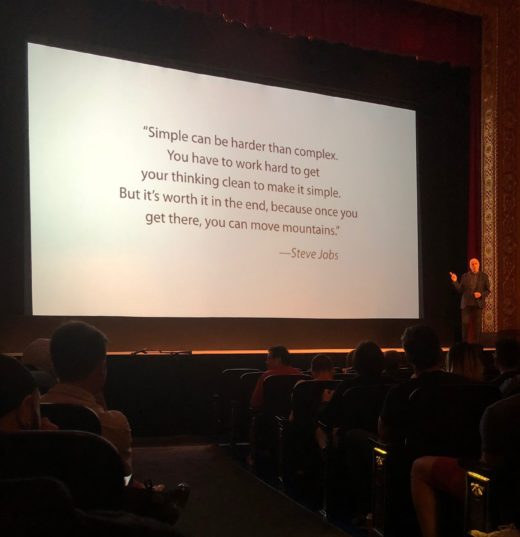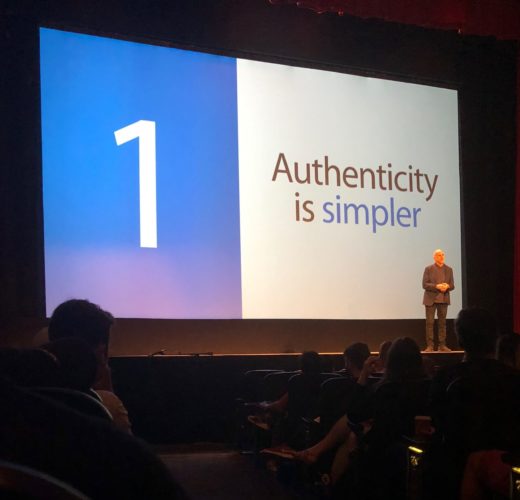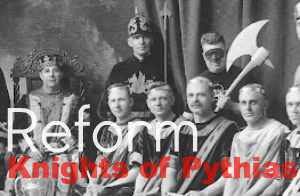A week or so ago, I went to the Michigan Theater to hear a lecture by Ken Segall, a former creative director at Steve’s Jobs’ go-to ad agency, TBWA\Chiat\Day. Segall, who worked with Jobs for over a dozen years, as the maverick tech entrepreneur moved between NeXT and Apple, is credited as having both authored Apple’s hugely successful “Think different” campaign in ’97, and named the iMac in ’98. Segall, now an author of marketing books on the subject of simplicity, like the popular Insanely Simple, had been brought to Ann Arbor by the folks at the local tech startup Trove, and, as long as he was here in town, someone had the bright idea to put together a public event at the Michigan Theater, which I was fortunate enough to hear about. What follows are my abbreviated notes, for those of you who are interested in marketing, product naming, the history of Apple, or just the idea of simplicity in general.
[above: That’s Ken Segall to the right of the giant quote from Steve Jobs.]
• Apple’s first logo, drafted by company co-founder Ronald Wayne, was, to put it kindly, something of a mess. It was a drawing of Sir Isaac Newton sitting beneath an apple tree, accompanied by the text, “Newton… a mind forever voyaging through strange seas of thought… alone.” It was ornate, and unnecessarily complicated. From that point in Apple’s history, Segall said, it was all about stripping things away in an attempt to get at the underlying essence. And this is something that Segall kept coming back to during his talk… this need to get at a more pure, simplified distillation of that which you’re attempting to convey, whatever it might be. This, it was clear, was the big lesson he learned during his time with Jobs… Here’s that first Apple logo, a far cry from the iconic apple that eventually came to represent the company. [The simple, elegant Apple logo we know today was first conceived of by Rob Janoff in 1977, not long after this first logo of Wayne’s was rolled out.]
• At Apple, Segall said, Jobs was always looking to pare things down. When Jobs returned to Apple from NeXT, Segall said, he eliminated a good number of their product lines. Jobs, Segal told us, whittled the company’s product offerings down to just four models, whereas HP and Dell had 26 and 41 respectively. This wasn’t about giving customers less choice, Segall argued. It was about giving them less confusion. People don’t like being paralyzed by choices, he said. “Do fewer things, and do them better,” was the edit at Apple, he said. [Jobs cut away at Apple’s product offerings until all that was left were four items that could fit in a simple 2 x 2 matrix. “Home” and “Pro” were on one axis. “Desktop” and “Laptop” were on the other.]
• Simple things, Segall said, at least in the world of advertising, aren’t actually simple. It’s the “perception of simplicity” that you’re striving for, he said. And the way to get there, according to him, was through authenticity. Authenticity, he argued, can be a shortcut to simplicity, or, as he would say, the perception of simplicity. “Authenticity is simpler,” he said.
• “Simplicity breeds love,” Segall said. You want an emotional bond with your customers, he told the audience. Bad things will inevitably happen over the lifespan of any brand, and you need for people to stick with you through those times. In order for people to do that, they need to really love your brand. You need to speak “humanese,” and connect with people. You want to, “simplify, and then beat that message to death,” he argued, until it’s pat of them. You want them to love you so much that they’re willing to overlook the occasional mistake.
• Illustrating this quest for simplicity, Segall shared “The Bull,” a series of 11 lithographs created by Pablo Picasso in later 1945. Through the series, the artist continued, through a process of abstraction, to get to the true “spirit” of the animal.
• “Leave out the layers of detail,” he said. Your customers don’t need it. They don’t have to know every nuance. They just need to know the underlying, authentic spirit of what you’re trying to do. That, he argued, is what will resonate with them.. We “make progress,” he said, “by removing the superfluous.”
• Jobs, he said, wanted to call the iMac the “MacMan,” but they kept pushing through it, offering alternatives that, in their opinion, better conveyed the real power of the new model, which was its ability to elegantly deliver internet (“i”) into the home without external modems, and the tangle of wires that, up to that point, had been necessary. The idea was that this new model was a faster, less complicated, more user-friendly way to get internet connectivity in the home, and the name iMac, they were eventually able to convince Jobs, best conveyed that.
• The announcement of the iMac, he said, “paid off’ the “Think different” campaign beautifully… They’d been running “Think different” ads for months, in response to IBM’s “Think” slogan, and, when they unveiled the iMac, it all came together. They announced to the world that they weren’t going to be just another beige box, but that they were going to focus on user experience, style and the human-computer interface… things which, until then had been overlooked.
















5 Comments
I didn’t mention it in the post, but Segall has been critical of Apple over in recent years for having “lost it’s personality”.
I have an 1960’s era IBM ‘think’ desk sign that I salvaged from a thrift bin for 50 cents. Seems it needs to be paired with a ‘think different’ piece and go to live in a creative studio suite of offices somewhere….
Kinda like Ann Arbor losing its personality over the years.
Rick– yes. What we lost in Ann Arbor are our creative people and workers. Even the brilliant young people we grow in Ann Arbor are forced to leave. My daughter’s friends who stayed in MI all moved to Ypsi. We have lots of high performing/earning people far too busy to contribute to the culture in ways that move it forward or that make daily life interesting, We are homogenized. Not sure if the Apple correlation applies there. But many companies lose their mojo when they get too comfortable as well. I’m wondering if tech is really producing disruptors anymore. It seems like it is monopolized.
tangentially related take on the broader ideology of apple from ian svenonious (dude from nation of ulysses, the make-up etc.). from a few years ago:
https://www.jacobinmag.com/2014/07/all-power-to-the-pack-rats/